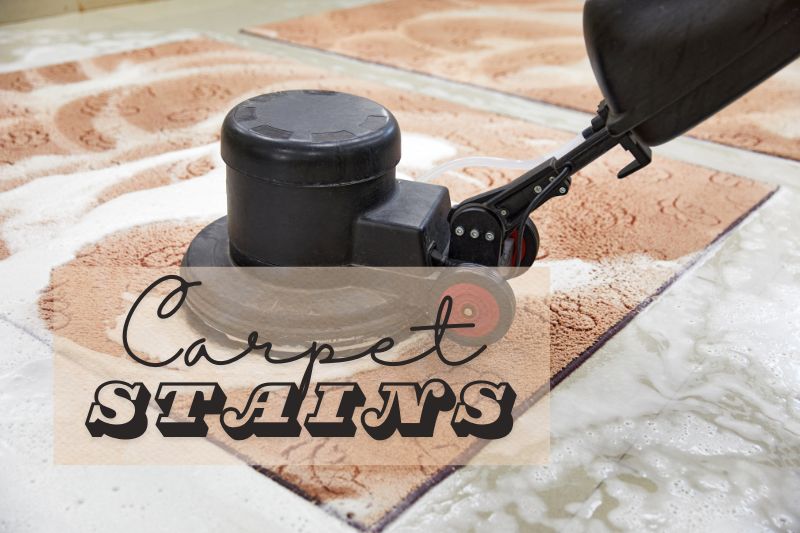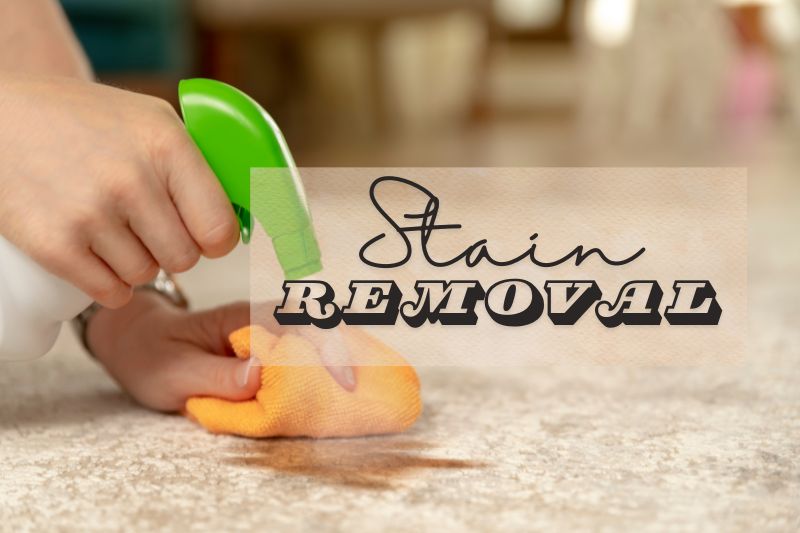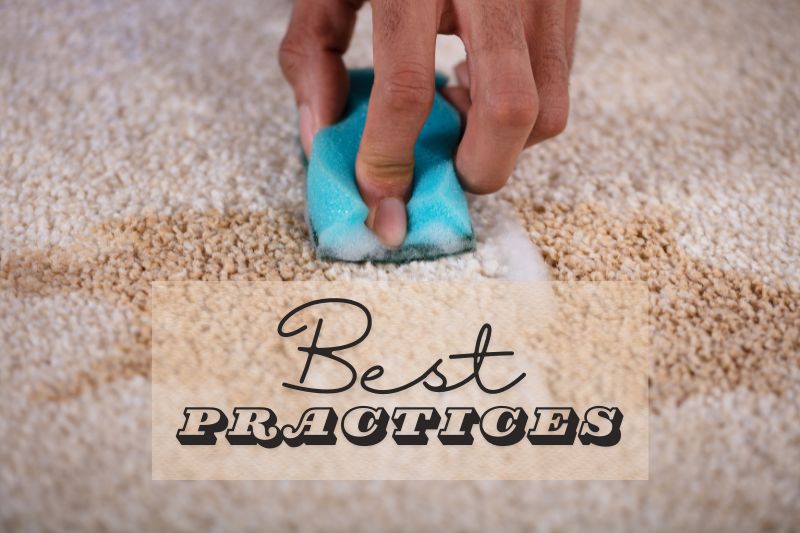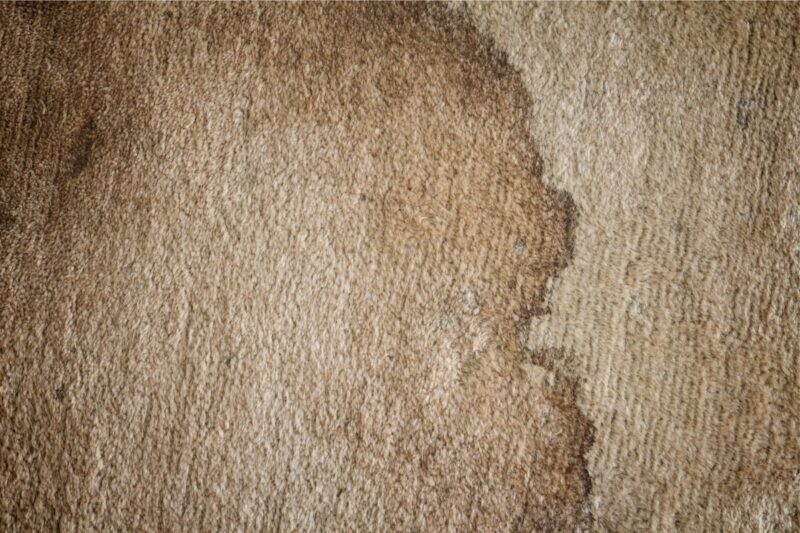Carpets add warmth and style to your home, but they can attract tough stains. Mix 1/4 teaspoon of liquid dish soap, 1 tablespoon of white vinegar, and 1 cup of warm water to tackle most stains. Gently dab the stain with a clean, white cloth soaked in this solution.
For older stains, you can use a mix of baking soda and vinegar. Sprinkle baking soda on the stain and then spray a mixture of equal parts white vinegar and water onto the area. This combination works well for grease and other stubborn stains.
For the toughest stains, like those that have set in for a long time, try using borax powder. Apply the borax, let it settle and dry, then vacuum it up. This method can help lift deep, embedded stains from your carpet.
Identifying Carpet Stains

Understanding the type of stain on your carpet is crucial for choosing the right cleaning method.
Different stains require different treatments, and using the wrong technique can make the stain worse.
Classifying Stains by Type
Carpet stains can be water-soluble or non-water-soluble. Water-soluble stains are easier to clean and include things like juice, soda, and mud. Non-water-soluble stains include grease, oil, and tar.
For water-soluble stains:
- Mix a teaspoon of dishwashing detergent with a cup of warm water.
- Blot the stain gently without rubbing.
For non-water-soluble stains:
- Use a small amount of dish soap mixed with water.
- You might need a stronger cleaner, like a solvent-based stain remover.
Common Household Stains
Common household stains include coffee, red wine, and pet stains. These can be more tricky to remove.
For coffee stains:
- Blot with water, then use a dish soap solution.
- If persistent, a mix of vinegar and water can help.
Red wine stains:
- Blot immediately with a clean cloth.
- Use a mix of baking soda and water to lift the stain.
Pet stains (urine, vomit):
- Blot the area to remove excess liquid.
- Use an enzymatic cleaner specifically designed for pet stains.
Grease stains:
- Sprinkle baking soda to absorb the grease.
- Follow with a dish soap solution.
Ink stains:
- Use isopropyl alcohol on a cloth and dab the stain.
- Avoid rubbing to prevent spreading the ink.
Identifying the type of stain is your first step to a clean carpet. Choose the right method to tackle each kind of stain effectively. Avoid over-wetting the carpet, which can cause mold or mildew. Your goal is to target the stain while keeping the carpet fibers intact.
DIY Stain Removal Techniques

To keep your carpets looking fresh, you can use common household items to tackle tough stains. The following tips focus on effective methods you can try at home.
Using Pantry Staples
You’ll be surprised how many pantry items can help with carpet stains. Baking soda is great for deodorizing and lifting stains. Sprinkle it over the stained area and let it sit for a few hours before vacuuming it up. If you’re dealing with liquid spills, salt or cornstarch can absorb moisture and make cleanup easier.
White vinegar is another versatile cleaner. Mix equal parts vinegar and water in a spray bottle. Spray directly on the stain and let it sit for a few minutes. Blot with a clean cloth and repeat if needed. This is effective for stains from coffee, wine, and pets.
Club soda is useful for fresh stains, especially those from soft drinks or wine. Pour a small amount over the stain and blot with a cloth until the stain is lifted. Repeat as necessary.
Homemade Solutions
Creating your own stain remover is easy and usually involves items you already have. For a general cleaning solution, mix one teaspoon of liquid dish soap, one teaspoon of white vinegar, and two cups of warm water. Apply this mixture to the stain with a cloth, blotting rather than rubbing to avoid spreading the stain.
For tougher stains, try a mix of hydrogen peroxide and baking soda. Sprinkle baking soda over the stain first, then spray a mixture of one part hydrogen peroxide to two parts water over it. Let it sit for a few minutes, then blot up with a clean cloth.
For a protein-based stain like blood or urine, an enzyme cleaner works best. If you don’t have one, you can create a solution using ammonia and water. Mix one tablespoon of ammonia with half a cup of water and apply to the stain. Be cautious with ammonia on colored carpets as it may cause fading.
By using these techniques, you can keep your carpets clean without the need for expensive store-bought cleaners.
Stain Removal Best Practices

Proper techniques are essential to effectively remove tough stains from carpets. By using the right methods, such as careful blotting and applying appropriate cleaning agents, you can minimize damage and keep your carpet looking fresh.
Blotting vs. Rubbing
When dealing with carpet stains, blotting is your best friend. Use an absorbent cloth or paper towels and press gently to absorb the liquid. Blot from the outside in to prevent the stain from spreading.
Avoid rubbing the stain at all costs. Rubbing can push the stain deeper into the carpet fibers and damage them. Instead, gently dab the area to lift the stain without spreading it.
Remember to use a clean, white cloth to prevent color transfer to the carpet. The goal is to soak up as much of the liquid as possible without grinding dirt into the fibers.
Applying Cleaning Agents
Once you have blotted the stain, it’s time to apply a cleaning agent. A common solution is to mix one teaspoon of dishwashing detergent with one cup of warm water. After blotting as much liquid as you can, apply the solution using a clean cloth.
Be careful not to saturate the carpet fibers. Over-wetting can lead to further damage. Instead, blot the solution into the carpet carefully. If you’re dealing with tougher stains, you can use soda water or a mix of vinegar and water.
Rinse the area with lukewarm water to remove any residue from the cleaning agents. Once the area is clean, blot with dry paper towels to absorb any remaining moisture. Repeat the process if necessary until the stain is completely gone.
Professional Carpet Cleaning
Professional carpet cleaning can help when dealing with particularly tough stains. Knowing when to hire professionals and understanding the benefits can save time and ensure your carpet lasts longer.
When to Hire Professionals
You might need to hire professionals for carpets with old or stubborn stains that aren’t responding to DIY methods. Professionals use advanced cleaning methods, like hot water extraction, that can effectively remove deep-seated stains and soiling.
Heavy soiling or large areas affected by pet stains and odors are best handled by experts. They have access to specialized carpet stain removers and machines that are more powerful than what you can buy or rent.
Frequent high traffic areas, such as living rooms or hallways, often require the attention of a professional carpet cleaner.
Benefits of Professional Cleaning
Professional carpet cleaners can extend the life of your carpet. They use effective techniques and high-quality equipment that provide a deeper clean compared to standard home methods.
Professional cleaning also improves indoor air quality as it removes dust, allergens, and bacteria trapped in the carpet fibers.
Regular professional cleaning can maintain your carpet’s appearance, making it look fresh and new. This is especially beneficial if you plan to sell your home or host events.
A portable professional unit might be less effective than a truck-mounted system, which are commonly used by professionals for larger homes or businesses. These systems provide a more thorough and quicker drying process.
Hiring professionals ensures that your carpets are treated safely, without damage to fibers or color.

